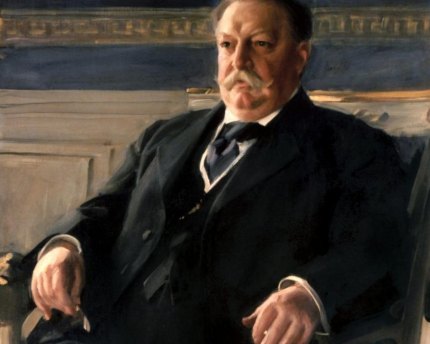
Taft was the 27th president of the United States (1909-1913) and the 10th chief justice (1921-1930). He also served as a Cabinet member (secretary of war) under President Theodore Roosevelt. But when historians rank presidents, Taft's name generally falls in the middle of the pack. Here is the rundown:
An auspicious beginning: Taft was born in 1857 in Cincinnati to politically involved parents. His father, Alphonso Taft served as secretary of war and then attorney general in President Ulysses S. Grant's Cabinet, notes Peri E. Arnold, professor of political science at University of Notre Dame, writing for the Miller Center at the University of Virginia. President Chester A. Arthur appointed Taft's father to serve as minister (ambassador) to Austria-Hungary and Russia.
Taft's mother, Louisa Maria Torrey Taft, was an organizer in the statewide kindergarten movement and traveled with her husband on diplomatic missions, the article reports.
Given that background, it was natural that Taft should begin to think along progressive lines. "When he graduated from high school in 1874, he chose for his graduation ceremony ... the subject of women's suffrage, telling the audience about his progressive parents," the Miller Center article recounts. Taft later graduated from Yale. Afterward, he returned to Cincinnati, where he studied at the University of Cincinnati Law School.
Marriage: Taft married Helen Herron, known as Nellie, in 1886. She was also a well-connected Ohioan. When Nellie was 17 years old, she visited the White House "as the guest of president (Rutherford Hayes) and Mrs. Hayes, intimate friends of her parents," explains the White House website. (Indeed, her father and Rutherford Hayes were once law partners). During this trip, she met her future husband at a sledding party. Later, she would play a role in his political rise. "Historians believe Helen 'Nellie' Herron saw a broader career for her husband beyond a series of judicial appointments and encouraged him to accept positions that got him off of the bench and into Washington political circles," according to the National Constitution Center.
First appointments: Armed with his father's connections, Taft began his law career, becoming assistant prosecutor of Hamilton County, Ohio, in 1881, the Miller Center website explains: "Thereafter, he worked as a lawyer for a few years before being appointed judge of the Cincinnati Superior Court in 1887. From an early point in his career, he aspired to a seat on the U.S. Supreme Court. He was appointed U.S. solicitor general in 1890 (the third highest position in the Department of Justice)." Taft was 32 years old at the time, the youngest person to hold the job.
Roosevelt also offered Taft a position on the Supreme Court, but Taft declined. Taft's wife, Nellie, "persuaded him not to bury himself on the Court at the very moment when, as secretary of war, he was being touted throughout the country as Roosevelt's most likely successor," explains Doris Kearns Goodwin in The Bully Pulpit, (Simon and Schuster; 2013).
Elected president: After serving as secretary of war 1904-1908, Taft was Roosevelt's handpicked candidate. He became the Republican candidate and won the election, defeating William Jennings Bryan (1860-1925), a Democrat.
The Roosevelt split: Eventually, Taft lost Roosevelt as an ally. "By the time he left the White House in March 1909, Roosevelt believed that the federal government must do more to supervise large corporations, improve the lot of women and children who worked long hours for low wages in industry, and conserve natural resources," according to Lewis L. Gould in the Smithsonian magazine article, "The 1912 Republican Convention." "As president, Taft had sided with the conservative wing of the party, which had opposed Roosevelt's reforms at every turn. For his part, Taft believed Roosevelt had stretched the power of the executive branch too far," the article states.
A one-term president: Taft was again the Republican nominee in 1912. But Roosevelt ran as a third party candidate for the progressive Bull Moose Party. The country elected the Democratic nominee, Woodrow Wilson. Roosevelt finished second. Taft came in third.Supreme Court: Nearly a decade later, Taft's Supreme Court dream became a reality. In June 1921, President Warren Harding nominated Taft, 63, to lead the high court. Taft served nine years as chief justice. He "proved an efficient judicial administrator, swiftly dispatching the court's clogged docket," according to The Complete Book of Presidents, by William A. DeGregorio and Sandra Lee Stuart, (Barricade Books; 2013). "During his nine years on the bench, he wrote 253 opinions, about one sixth of all the decisions handed down during his term."
Death: Health problems led Taft to resign from the court in February 1930. He died soon after, March 8.
To know more:
- The Bully Pulpit by Doris Kearns Goodwin (Simon and Schuster; 2013).
- The Complete Book of Presidents, by William A. DeGregorio and Sandra Lee Stuart, (Barricade Books; 2013).
- Encyclopedia Britannica: United States Presidential Election of 1912, by the editors of Encyclopedia Britannica.
- Miller Center at the University of Virginia: William Taft: Life Before the Presidency, by Peri E. Arnold, professor of political science, University of Notre Dame.
- National Constitution Center: 10 birthday facts about President and Chief Justice William Howard Taft, by National Constitution Center staff, Sept. 15, 2019.
- Smithsonian Magazine: 1912 Republican Convention, Return of the Rough Rider by Lewis L. Gould, August 2008.
- WhiteHouse.gov: William Howard Taft.
- WhiteHouse.gov: Helen Herron Taft.
Like us on Facebook and tell us what you think.